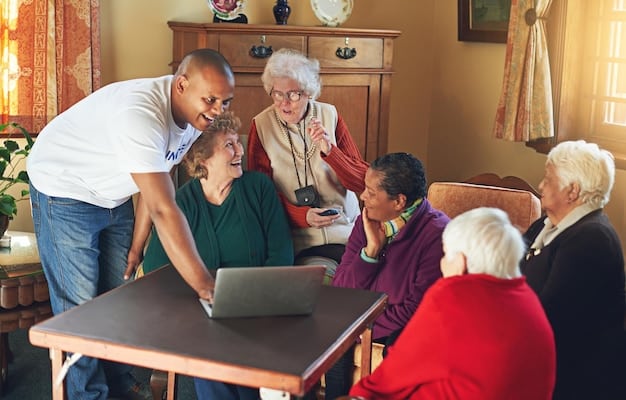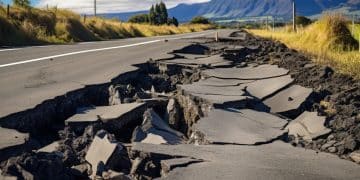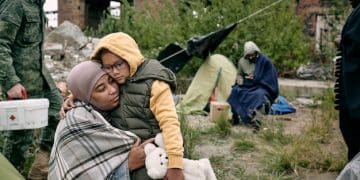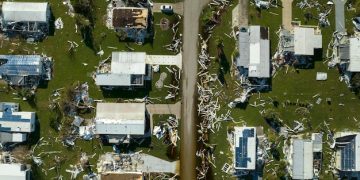Emergency Communication Plans: Stay Connected During US Disasters

Emergency communication plans are vital for ensuring that individuals and communities in the US stay connected, informed, and safe during disasters, offering strategies and tools to maintain communication when standard systems fail.
Disasters can strike at any moment, disrupting our lives and cutting us off from the information and people we need most. In the US, where extreme weather events and other emergencies are increasingly common, having robust emergency communication plans is no longer optional—it’s essential for staying connected and safe.
Understanding the Importance of Emergency Communication Plans
In times of crisis, effective communication is critical. An emergency communication plan is a strategy designed to ensure that you can stay in touch with family, friends, and emergency services when traditional communication methods are unavailable.
These plans include everything from identifying meeting points to establishing alternative means of communication, ensuring that you and your loved ones can coordinate and support each other effectively, no matter the circumstances.
Why Standard Communication Systems Fail During Disasters
During a disaster, power outages, cellular network congestion, and damage to infrastructure can render standard communication systems useless. Overwhelmed networks struggle to handle the surge in call volume, and downed power lines can knock out landline phones.
This is why relying solely on these systems can be dangerous. An emergency communication plan provides backups and alternatives to mitigate these risks.
- Power Outages: Most modern phones rely on electricity; no power means no communication.
- Network Congestion: Cellular networks can become overloaded as everyone tries to call for help or check on loved ones.
- Infrastructure Damage: Natural disasters can physically damage cell towers and phone lines.
- Geographic Isolation: Certain rural areas may have limited or no access to reliable communication networks under normal circumstances, making them even more vulnerable during disasters.
Having a comprehensive communication plan ensures that these communication breakdowns turn into obstacles, not roadblocks.

Essential Elements of an Emergency Communication Plan
Creating an effective emergency communication plan involves considering several key elements. These include identifying potential meeting points, establishing contact protocols, and exploring alternative communication methods.
Each element should be tailored to your family’s specific needs and the types of disasters most likely to occur in your area.
Establishing Meeting Points
Having designated meeting points is crucial if family members are separated when a disaster strikes. These locations should be easily accessible and known by everyone in the family.
Consider having both a local meeting point (e.g., a neighbor’s house or a nearby park) and an out-of-area meeting point in case local areas are inaccessible.
Creating a Contact List
Compile a list of important contacts, including family members, friends, doctors, and emergency services. Keep a hard copy of this list in an easily accessible location, such as a wallet or emergency kit.
- Include both local and out-of-state contacts, as local networks may be disrupted.
- Ensure every family member has a copy of the list.
- Update the list regularly to ensure all information is current.
This preparedness will allow for greater connectivity if needed.
Alternative Communication Methods
When traditional communication systems fail, alternative methods can be lifesavers. These include tools like two-way radios, satellite phones, and social media.
Understanding and utilizing these options can significantly enhance your ability to stay connected during a disaster.

Two-Way Radios (Walkie-Talkies)
Two-way radios provide a reliable means of short-range communication without relying on cellular networks. They are particularly useful for staying in touch with family members in the immediate vicinity.
Ensure you choose radios with sufficient range and battery life for your needs.
Satellite Phones
Satellite phones can bypass damaged terrestrial networks, providing connectivity in remote areas or during widespread communication outages. While they can be expensive, they offer a crucial lifeline when other systems fail.
Utilizing Social Media Responsibly
Social media platforms can be used to provide updates and request assistance during a disaster. However, it’s imperative to use these platforms responsibly and verify information before sharing it.
- Use official emergency accounts for updates.
- Share only verified information from trusted sources.
- Be mindful of misinformation and hoaxes.
It’s important to remember that social media should be used with caution, as misinformation can spread quickly and cause unnecessary panic.
Practical Steps to Develop Your Family Plan
Developing a family emergency communication plan involves several practical steps. Start by assessing your communication needs, then create and document your plan, and test and revise it regularly.
This iterative process ensures that your plan is effective and up-to-date.
Assessing Your Family’s Communication Needs
Begin by identifying the specific communication needs of your family. Consider factors such as age, mobility, and any special medical needs.
Determine the most likely types of disasters in your area and how they might affect communication. This information will help form the strategy you execute.
Documenting Your Plan
Document your emergency communication plan in writing and ensure that every family member has a copy. Include all important contact information, meeting points, and instructions for using alternative communication methods.
- Keep copies in multiple locations, such as your home, car, and workplace.
- Consider creating digital copies stored in the cloud for easy access.
- Review and update the plan at least twice a year.
Consider laminating physical copies to protect them from water damage.
Leveraging Technology for Enhanced Communication
Technology offers numerous tools to enhance emergency communication. From smartphone apps to emergency alert systems, these resources can provide timely information and facilitate communication during a disaster.
Staying informed about these technologies can significantly improve your preparedness.
Smartphone Apps for Emergency Communication
Several smartphone apps can help with emergency communication. These apps often provide features such as real-time alerts, communication tools, and access to emergency resources.
Examples include apps that send alerts about severe weather, provide maps of evacuation routes, and facilitate communication with emergency services.
Emergency Alert Systems
Familiarize yourself with the emergency alert systems in your area. These systems typically use broadcast messages to warn residents about imminent threats, such as severe weather or evacuation orders.
- Sign up for local alerts through your city or county’s website.
- Enable Wireless Emergency Alerts (WEA) on your smartphone.
- Monitor local news and radio for updates.
These could be life-saving in an actual disaster.
Maintaining and Updating Your Plan
An emergency communication plan is not a one-time task. It requires regular maintenance and updates to ensure its continued effectiveness.
This includes periodically testing the plan, reviewing contact information, and adapting it to changing circumstances.
Regular Drills
Conduct regular drills to test your emergency communication plan. This can help identify any weaknesses and ensure that everyone knows what to do in a real emergency. Simulate different scenarios to prepare for the unexpected.
Reviewing and Adapting to Changing Circumstances
Review your emergency communication plan at least twice a year and adapt it to any changing circumstances. This includes updating contact information, adjusting meeting points, and incorporating new communication technologies.
| Key Element | Brief Description |
|---|---|
| 📍 Meeting Points | Designate primary and secondary locations for family members to gather. |
| 📞 Contact List | Maintain an updated directory of essential contacts, including out-of-state relatives. |
| 📻 Alternative Communication | Explore options like two-way radios and satellite phones if normal cell service is interrupted. |
| 📱 Emergency Apps | Utilize smartphone apps for real-time alerts and evacuation routes. |
Frequently Asked Questions
▼
An emergency communication plan ensures that you can stay in touch with family, friends, and emergency services during a disaster when standard communication methods are unavailable due to network failures or power outages.
▼
A contact list should include names, phone numbers, and email addresses of family members, friends, doctors, and emergency services. Include both local and out-of-state contacts.
▼
You should review your emergency plan at least twice a year and update it as needed to reflect changes in contact information, living situations, or new technologies available.
▼
Alternative communication methods include two-way radios, satellite phones, and social media. They are helpful when traditional cell networks are down during a disaster or emergency situation.
▼
Local meeting points are for immediate gathering, while out-of-area points work if the local area is inaccessible or unsafe. Having both ensures flexibility in different disaster scenarios.
Conclusion
Creating and maintaining emergency communication plans is a critical aspect of disaster preparedness in the US. By understanding the importance of staying connected, developing a comprehensive plan, and leveraging available technologies, individuals and families can significantly enhance their safety and resilience during times of crisis.





